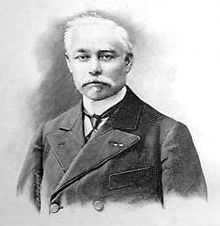Guillaume Bigourdan
| 390 Alma | March 24, 1894 |
| Camille Guillaume Bigourdan | |
|---|---|
 | |
| Born |
April 6, 1851 Sistels |
| Died |
February 28, 1932 (aged 80) Paris |
| Nationality | France |
| Fields | astronomy |
Camille Guillaume Bigourdan (April 6, 1851 – February 28, 1932) was a French astronomer.
Bigourdan was born at Sistels, Tarn-et-Garonne to Pierre Bigourdan and Jeanne Carrière.[1] In 1877 he was appointed by Félix Tisserand as assistant astronomer at the Toulouse Observatory, and in 1879 followed Tisserand to the Paris Observatory when the latter became director there.
He spent many years verifying the positions of 6380 nebulas. He hoped to set a basis for future studies of the proper motion of nebulas; this turned out to be more or less in vain, since distant nebulas will not show any proper motion. However, he did discover approximately 500 new objects.
In 1902 he participated in an effort to redetermine with greater precision the longitude difference between London and Paris. He became a member of the Bureau des Longitudes in 1903, and a member of the French Academy of Sciences in 1904.
He described a method for adjusting equatorial mount telescopes, which was known as "Bigourdan's method".
Bigourdan won the Lalande Prize of the French Academy of Sciences in 1883 and in 1891, and the Gold Medal of the Royal Astronomical Society in 1919. He was director of the Bureau International de l'Heure from 1919 to 1928.
He married a daughter of Amédée Mouchez.
References
- ↑ Hockey, Thomas (2009). The Biographical Encyclopedia of Astronomers. Springer Publishing. ISBN 978-0-387-31022-0. Retrieved August 22, 2012.
Further reading
- Levy, Jacques R. (1970–80). "Bigourdan, Camille Guillaume". Dictionary of Scientific Biography 2. New York: Charles Scribner's Sons. pp. 126–127. ISBN 0684101149.
External links
- Obituaries
|